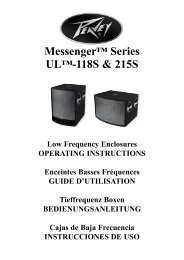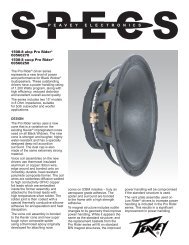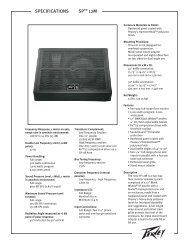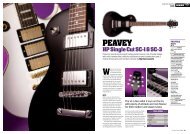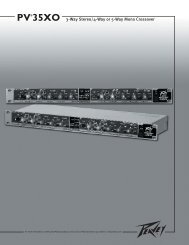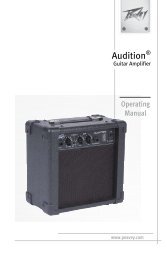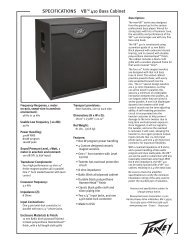tragic 4 pxd peavey
tragic 4 pxd peavey
tragic 4 pxd peavey
Create successful ePaper yourself
Turn your PDF publications into a flip-book with our unique Google optimized e-Paper software.
Bass Guitars<br />
Owner's Manual
Passive Bass<br />
Guitar<br />
Configuration<br />
5<br />
6<br />
7<br />
3<br />
8<br />
9<br />
10<br />
11<br />
12<br />
4<br />
3<br />
2<br />
1<br />
1. Volume<br />
2. Tone Control<br />
3. Pickup Blend Control<br />
4. Strap Button<br />
5. Bridge<br />
6. Bridge Pickup<br />
7. Neck Pickup<br />
13<br />
8. Position Markers<br />
9. Frets<br />
10. Fingerboard<br />
11. Nut<br />
12. Tuning Keys<br />
13. String Retainer<br />
2
5<br />
6<br />
7<br />
Active Bass<br />
Guitar<br />
Configuration<br />
4<br />
3<br />
8<br />
9<br />
10<br />
11<br />
12<br />
3 2 1<br />
1. Volume<br />
2. 3 band active EQ with<br />
+-/10 dB boost or cut<br />
3. Pickup blend control<br />
4. Strap Button<br />
5. Bridge<br />
6. Bridge Pickup<br />
7. Neck Pickup<br />
8. Position Markers<br />
13<br />
9. Frets<br />
10. Fingerboard<br />
11. Nut<br />
12. Tuning Keys<br />
13. String Retainer<br />
3
Congratulations<br />
So, you are the owner of a new Peavey Bass Guitar. Congratulations! Your<br />
purchase proves your taste in musical instruments is superb. Peavey offers a wide<br />
variety of bass guitars for beginners to professionals, each with unique qualities and<br />
features. While our professional luthiers have carefully inspected your guitar, every<br />
model requires some initial set-up and periodic maintenance is required for peak<br />
performance.<br />
To insure proper care of your quality instrument, visit www.<strong>peavey</strong>.com for Peavey<br />
recommended accessories, parts and cleaning supplies.<br />
4
Cleaning & Care<br />
When properly cared for, your Peavey bass will offer you years of pleasure.<br />
Playing your bass means that you will need to perform regular, general<br />
maintenance, such as cleaning and proper storage, to keep it looking and<br />
sounding great.<br />
Every time you play your bass, body oils and perspiration are transferred to the<br />
body, back of the neck, headstock, fingerboards, strings, tuners, pickups and<br />
bridge. After you finish performing, but before you put your bass away, take a<br />
moment to remove these contaminants.<br />
5
Cleaning - Wood<br />
To clean and care for the major wood parts of your bass guitar<br />
(body, headstock and the back of the neck), Peavey recommends<br />
that you use a clean, soft, lint-free, dry cotton or<br />
Peavey Micro Fiber cloth and specially formulated HP's<br />
Axe Wax available at www.<strong>peavey</strong>.com. Use of an<br />
inappropriate “rag” or polish may result in scratching<br />
the finish of your instrument.<br />
WARNING: Use of abrasives or solvents<br />
will permanently damage your<br />
instrument's finish.
Cleaning - Fingerboard<br />
Properly caring for your fingerboard requires special attention. Over time, a fingerboard may lose its<br />
natural oils and shrink or exhibit a worn or faded appearance. Peavey recommends that you periodically<br />
apply a small amount of Lemon Oil (available at www.<strong>peavey</strong>.com) to your fingerboard (after removing<br />
strings) using a clean, soft, lint-free, dry cotton cloth. Remove excess oil immediately using a clean, soft,<br />
lint-free, dry cotton cloth. With Lemon Oil, like all oils, a little goes a long way. Make sure to use only<br />
a small amount. How do you know when it is time to replenish your fingerboard You can watch for a<br />
change in the appearance of your wood, or set a routine calendar date. However, do not allow too much<br />
time to pass as permanent damage may occur. If you allow the wood on the fingerboard to dry out and<br />
shrink, the frets will “stand-out” and feel rough to the touch.<br />
7
Cleaning - Metal<br />
To clean and lubricate the major metal parts of your<br />
bass (strings, pickups, bridge, tuners), Peavey recommends<br />
that you use a clean, soft, lint-free, dry cotton<br />
cloth and specially formulated guitar string cleaner<br />
available at www.<strong>peavey</strong>.com. Don’t just wipe down<br />
the tops of your strings. Individually clean strings by<br />
wrapping each one in a fold of cloth, running it back<br />
and forth along the string’s entire length until the<br />
cloth fails to pick up any more residue. Failure to<br />
routinely clean and lubricate the metal parts of<br />
your instrument, including strings, may result<br />
in rusting.<br />
WARNING: Use of abrasives or solvents will<br />
permanently damage your finish.<br />
8
Storage & Travel<br />
Your bass is a piece of art that must be protected.<br />
When you are traveling with your instrument,<br />
loosen the tuning knobs a turn or two to<br />
take pressure off he neck, and protect it with<br />
a gig bag or case. While a gig bag offers some<br />
protection, mainly from dust, a hard case offers<br />
the best protection. If you plan to store your<br />
bass for a long period of time (we don’t know<br />
why you would want to), remember to slightly<br />
loosen your strings to relieve pressure on the<br />
neck. As with any piece of art, don’t throw it in<br />
your trunk and leave it when it’s -10° or 110°!<br />
Keep you bass stored at room temperature,<br />
and avoid extreme changes in temperature<br />
or humidity.<br />
9
Accessories<br />
Add-on products like stands, hangers, and straps that are made of plastic, rubber,<br />
or man-made materials may chemically or physically react with and damage the<br />
finish of your Peavey bass. (Peavey offers a full line of safe products available at<br />
www.<strong>peavey</strong>.com).<br />
Every player needs a strap for peak performance, however, straps and strap buttons<br />
are designed for “ordinary” use. If you anticipate “above ordinary” use, Peavey<br />
recommends that you use Super Strap Locks to secure your strap to your bass (See<br />
Peavey accessories www.<strong>peavey</strong>.com).<br />
REMEMBER: Peavey Care Kits offer the best<br />
value for your money. Visit www.<strong>peavey</strong>.com<br />
to place your order.<br />
10
Strings<br />
Old strings produce dull, buzzing or dead notes, while a new set of strings ring clear<br />
and true. If you play often, you will need to change your strings often. A good rule<br />
of thumb is that if you play daily, you should change strings every couple of<br />
weeks. Replace your strings as you notice them becoming dirty or discolored,<br />
before you experience a disappointing loss of performance.<br />
See page 12 for detailed instructions on changing strings.<br />
11
Changing Your Strings<br />
Unless you are reconditioning your fretboard (see care and<br />
cleaning), strings should be changed one at a time to maintain<br />
proper neck tension. New strings should be free of defects<br />
(twists, kinks, bends) that can cause sound irregularities or<br />
breakage. All strings are prone to stretch, particularly upon<br />
installation. After your first tuning, carefully pull each string<br />
away from the fretboard, stretching it gently (too much force<br />
will break thinner strings). Then, retune your guitar.<br />
Peavey recommends that you replace strings in the same<br />
gauges to maintain proper neck and/or bridge tension. If you<br />
wish to change strings with different gauges, Peavey recommends<br />
that you enlist the services of a qualified technician to<br />
make the required truss rod and/or bridge adjustments on your<br />
instrument.<br />
12<br />
Standard Tuning<br />
(thickest string to thinnest)<br />
4-String Bass Tuning<br />
Open note<br />
E A D G<br />
String 4 3 2 1<br />
5-String Standard Low B<br />
Adds one lower pitched string<br />
Open note B E A D G<br />
String 5 4 3 2 1<br />
5-String Alternative High C<br />
Adds one higher pitched string<br />
Open note E A D G C<br />
String 5 4 3 2 1<br />
6-String Bass Tuning<br />
Open note B E A D G C<br />
String 6 5 4 3 2 1
Changing Your Strings<br />
Changing strings on a Peavey bass guitar is a simple task that will bring new life to your instrument.<br />
Tools Needed:<br />
Wire cutters<br />
Electronic tuner or pitch pipe (optional)<br />
Note: Peavey recommends changing one string at a time to maintain proper tension on the neck and<br />
bridge. Replace strings with the same gauges or you will need to make truss rod, spring tension, and<br />
intonation adjustments as described in this manual.<br />
First, detune the thickest, top string (the 6th, 5th, or 4th string, depending on your model) using the<br />
machine head tuner—two or three full turns should remove the tension on the string. Remove the string<br />
from the tuning peg; at the other end of the string, pull the ball end of the string and remove the string<br />
from the instrument. (You may wish to cut off the portion of the string previously wound around the tuning<br />
peg to make this task easier.)<br />
13
Changing Your Strings<br />
Following the path of the string you just removed, insert the plain end of a new string through the hole<br />
in the bridge and thread across the string saddle, up the fingerboard, across the nut, through the string<br />
guide (if one is provided), and into the small hole in the corresponding machine head tuning post. (The<br />
ball end of the string will secure the string to the bridge.) At the headstock, allow 2-3 inches of string<br />
beyond the post for turning around the machine head post, and cut string. Insert the freshly cut string<br />
end into the hole in the center of the tuning post. Then, bend the string at a right angle at the edge of<br />
the slot and begin winding the string onto the post. Note that the string path should be straight, running<br />
from the fretboard, over the nut, through the string guides (if provided), to the post—without angling<br />
off. To avoid slippage, wind strings tightly from top to bottom on each post, completing 2-3 wraps<br />
around each post. Keep a light pressure on the string with the fingers of your other hand while tightening<br />
the string using the tuners. (An inexpensive, optional peg winder makes winding much easier.) Tune<br />
to pitch. Because new strings are prone to stretch when first installed, you should gently stretch the<br />
string by pulling it away from the neck and retune again.<br />
14
Changing Your Strings<br />
Note: Do not make saddle adjustments unless you are changing string gauges, which also requires<br />
truss rod and intonation adjustments.<br />
Repeat this procedure for the remaining strings, remembering to tune each to pitch before proceeding<br />
to the next string. Hint: To prevent detuning from slippage, always tune UP to the correct pitch. Retune<br />
each string until strings hold their relative pitch to one another.<br />
15
Tuning Machine Adjustments<br />
Over time, tuners can become loose. Get in the habit of checking the tension with every string change. If<br />
you notice a change in the tension of a tuner, use a small flathead or Phillips screwdriver (some require<br />
an allen wrench) to tighten it (turn clockwise) or loosen it (turn counterclockwise) accordingly.<br />
Warning: While the screw should be snug, do not over-tighten as you may strip the screw.<br />
16
String action refers to the distance between the strings and<br />
the frets on a stringed instrument. Peavey technicians carefully<br />
set optimal string action on each bass guitar before<br />
it leaves our factory; however, conditions such as changes<br />
in temperature and moisture (humidity), changing string<br />
gauges, making neck adjustments, or tuning can alter string<br />
action enough to require a height adjustment to restore<br />
your guitar to factory specifications. Undesirable low action<br />
causes buzzing, while abnormally high action makes your<br />
bass difficult to play.<br />
String Action<br />
Before making string action adjustments, make sure your<br />
truss rod is properly adjusted and your bass is in tune.<br />
17
Pickup Adjustments<br />
Factory settings place pickups at the same volume level;<br />
however many players change the height of one or<br />
more neck or bridge pickups to create their own output<br />
levels. To keep your factory warranty intact, Peavey<br />
suggests you take your bass to an authorized Peavey<br />
Service center to have the pickup adjustments made.<br />
18
Intonation<br />
A properly intoned bass guitar will sound in tune no matter where you play along<br />
the fretboard. Bass intonation describes the accuracy in relative pitch (of your bass<br />
with itself) as you play the same note or chord. Intonation is determined by the<br />
length of each string as controlled by the location of each string’s saddle. To check<br />
intonation, complete all adjustments to the truss rod and string action, and<br />
tune your guitar. Then, compare the fretted sound of the 12th fret to the<br />
open harmonic of the 12th fret. (Harmonics are created by lightly placing a<br />
finger against a string [in this case, at the 12th fret] and striking normally<br />
with your picking hand. You’ve done it correctly if you hear a clear, loud,<br />
bell-like tone.) If the notes are the same, no adjustment is required. If they<br />
do not match, you will need to fine-tune each offending string using the<br />
adjustment screws to move the saddle location. If the fretted 12th note is<br />
flat, adjust the saddle toward the neck. If sharp, move it away from the neck.<br />
(Note that on some bass guitars, you will need to loosen strings first before<br />
making saddle adjustments.) Repeat the process until the fretted sound of<br />
the 12th fret matches the open harmonic of the 12th fret.<br />
19
20<br />
Neck and Truss Rod<br />
Every Peavey bass guitar features an adjustable truss rod inside the neck. Truss rods<br />
allow for adjustments in the neck to accommodate changes in string tension caused<br />
by humidity, changing string gauges, or tuning. As the backbone of your instrument,<br />
truss rod adjustments should always be performed as the first step in instrument<br />
setup. (Peavey recommends that you enlist the services of a qualified technician to<br />
make the required truss rod adjustments on your instrument. Improper adjustment<br />
may damage your neck and void your Peavey warranty.) To gain access to the truss<br />
rod, look for a 4 mm or 8 mm allen wrench adjustment screw either at the end of<br />
the neck near the body or at the opposite end near the headstock. Note that some<br />
bass guitars may require neck removal to gain access to the neck pocket truss rod.<br />
The goal of truss rod adjustment is to create the correct amount of bow in your<br />
bass guitar’s neck to facilitate optimal playability.<br />
To check the neck’s bow, hold the guitar in normal playing position and follow<br />
this procedure for the both outside strings (highest and lowest strings). Fret and<br />
hold the string at the first fret, while fretting and holding the same string with<br />
your picking hand thumb (where the neck and body meet, typically around the<br />
16th fret). Then, stretch your picking hand index finger as far as you can to fret
Neck and Truss Rod<br />
the middle area of the neck, somewhere around fret 7-8-9. The distance your string travels to meet the<br />
fret is the bow. Peavey recommends a .3 mm to .5 mm (.010” to .020”) bow, easily measured and set<br />
with a steel rule. Too much bow leads to buzzing in the middle of the neck because the strings are too<br />
far away from the frets, while too little bow (backbow) causes excessive buzzing on open notes and<br />
notes near the nut.<br />
To make adjustments for neck bow or relief (backbow), adjust the truss rod in 1/4 turn increments,<br />
and then recheck. If your neck is backbowed, loosen the truss rod by turning it counterclockwise. If it<br />
has too much bow, tighten the truss rod by turning clockwise. Remember, a little truss rod adjustment<br />
makes a big change in neck attitude. Improper adjustment may damage your neck and void your Peavey<br />
warranty.<br />
21
Warranty<br />
Your Peavey Warranty covers defects in material and workmanship in Peavey products purchased and serviced in the U.S.A. and Canada.<br />
What This Warranty Does Not Cover<br />
The Warranty does not cover: (1) damage caused by accident, misuse, abuse, improper installation or operation, rental, product modification<br />
or neglect; (2) damage occurring during shipment; (3) damage caused by repair or service performed by persons not authorized<br />
by Peavey; (4) products on which the serial number has been altered, defaced or removed; (5) products not purchased from an Authorized<br />
Peavey Dealer.<br />
Who This Warranty Protects<br />
This Warranty protects only the original purchaser of the product.<br />
How Long This Warranty Lasts<br />
The Warranty begins on the date of purchase by the original retail purchaser. The duration of the Warranty for guitars is 2 years *(+ 3<br />
years). [* denotes additional warranty period applicable if optional Warranty Registration Card is completed and returned to Peavey by<br />
original retail purchaser within 90 days of purchase.]<br />
What Peavey Will Do<br />
We will repair or replace (at Peavey's discretion) products covered by warranty at no charge for labor or materials. If the product or<br />
component must be shipped to Peavey for warranty service, the consumer must pay initial shipping charges. If the repairs are covered by<br />
warranty, Peavey will pay the return shipping charges.<br />
How To Get Warranty Service<br />
(1) Take the defective item and your sales receipt or other proof of date of purchase to your Authorized Peavey Dealer or Authorized<br />
22
Warranty<br />
Peavey Service Center.<br />
OR<br />
(2) Ship the defective item, prepaid, to Peavey Electronics Corporation, International Service Center, 412 Highway 11 & 80 East, Meridian,<br />
MS 39301. Include a detailed description of the problem, together with a copy of your sales receipt or other proof of date of purchase as<br />
evidence of warranty coverage. Also provide a complete return address.<br />
Limitation of Implied Warranties<br />
ANY IMPLIED WARRANTIES, INCLUDING WARRANTIES OF MERCHANTABILITY AND FITNESS FOR A PARTICULAR PURPOSE, ARE LIMITED<br />
IN DURATION TO THE LENGTH OF THIS WARRANTY.<br />
Some states do not allow limitations on how long an implied warranty lasts, so the above limitation may not apply to you.<br />
Exclusions of Damages<br />
PEAVEY'S LIABILITY FOR ANY DEFECTIVE PRODUCT IS LIMITED TO THE REPAIR OR REPLACEMENT OF THE PRODUCT, AT PEAVEY'S OP-<br />
TION. IF WE ELECT TO REPLACE THE PRODUCT, THE REPLACEMENT MAY BE A RECONDITIONED UNIT. PEAVEY SHALL NOT BE LIABLE FOR<br />
DAMAGES BASED ON INCONVENIENCE, LOSS OF USE, LOST PROFITS, LOST SAVINGS, DAMAGE TO ANY OTHER EQUIPMENT OR OTHER<br />
ITEMS AT THE SITE OF USE, OR ANY OTHER DAMAGES WHETHER INCIDENTAL, CONSEQUENTIAL OR OTHERWISE, EVEN IF PEAVEY HAS<br />
BEEN ADVISED OF THE POSSIBILITY OF SUCH DAMAGES.<br />
Some states do not allow the exclusion or limitation or incidental or consequential damages, so the above limitation may not apply to<br />
you.<br />
This Warranty gives you specific legal rights, and you may also have other rights which vary from state to state.<br />
If you have any questions about this warranty or services received or if you need assistance in locating an Authorized Service Center,<br />
please contact the Peavey International Service Center at (toll-free) 877-732-8391 or customerservice@<strong>peavey</strong>.com. Features and specifications<br />
subject to change without notice.<br />
23
Features and specifications subject to change without notice.<br />
Peavey Electronics Corporation • 5022 Hartley Peavey Dr • Meridian, MS 39305<br />
(601) 483-5365 • FAX (601) 486-1278 • www.<strong>peavey</strong>.com<br />
© 2013 EX000058




